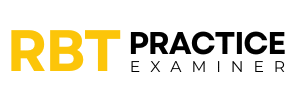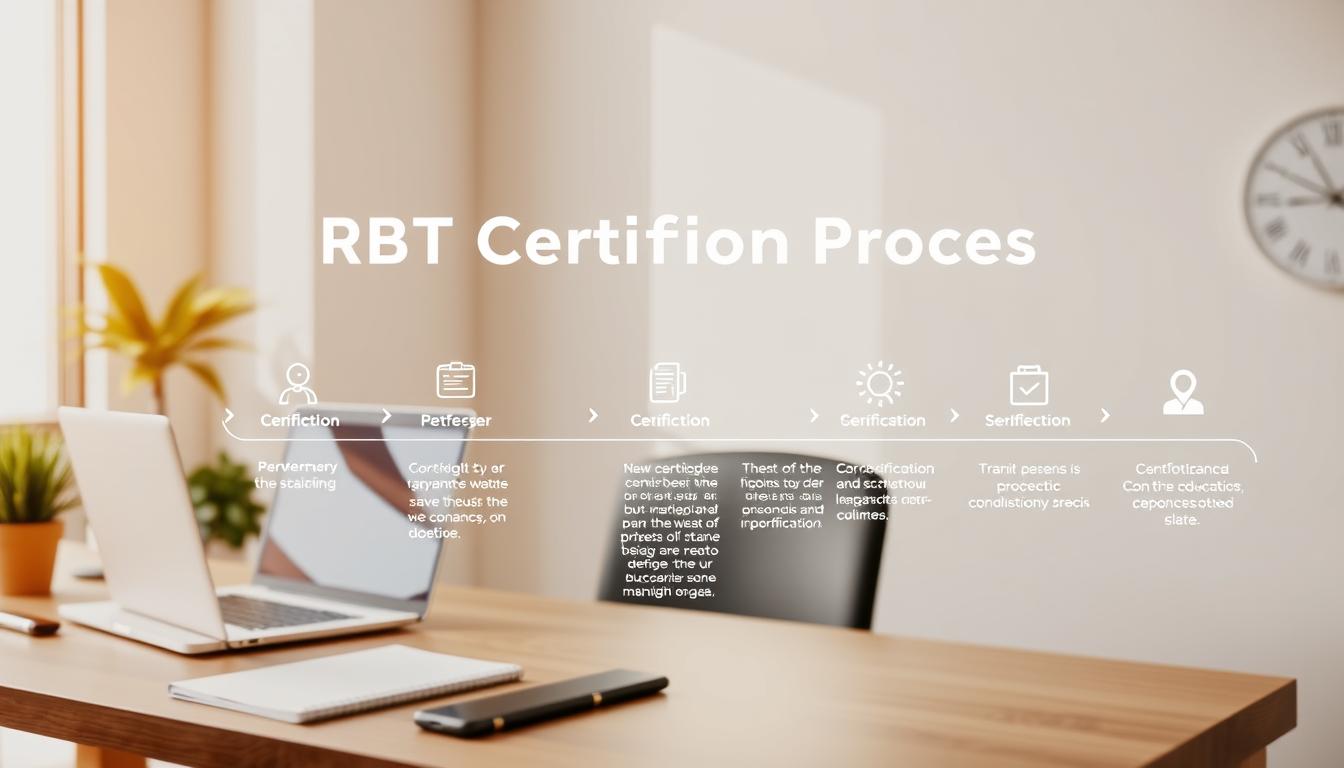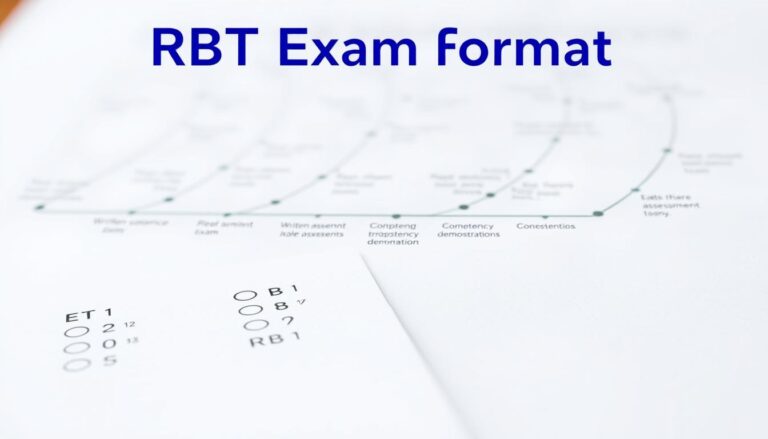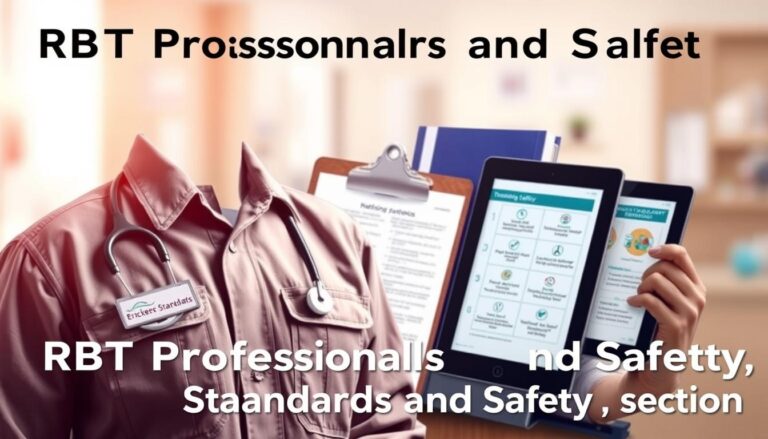Earn Your RBT Certification: What You Need to Know
Starting a career as a Registered Behavior Technician (RBT) is exciting. It leads to meaningful work in Applied Behavior Analysis (ABA). Knowing how to get RBT certified is the first step to a rewarding job. You’ll support people with developmental challenges.
The RBT certification process is a clear path for those eager to help. It shows you’re dedicated to providing top-notch support. This is for individuals needing special behavioral help.
The Behavior Analyst Certification Board created the RBT certification. It gives you key skills to work with clients under supervision. You’ll learn how to use behavior plans, collect data, and care for clients in schools, clinics, and private practices.
If you want to work in ABA, getting this certification is key. It proves your skills and opens doors for career growth in healthcare and special education.
Our guide will cover everything about becoming an RBT. We’ll talk about training, exam prep, and ongoing learning.
Understanding the RBT Role and Career Opportunities
Becoming a registered behavior technician is a rewarding career path. It’s for those who want to make a real difference in people’s lives. The field of Applied Behavior Analysis (ABA) offers many chances for a fulfilling career.
Getting RBT certification online is now easier. This lets new professionals join this field with flexible training. The job needs dedication, compassion, and special skills in behavioral intervention.
Key Responsibilities of a Registered Behavior Technician
Registered Behavior Technicians are key in helping clients. They do this by following plans made by experts. Their main tasks include:
- Collecting data on client behaviors
- Implementing specific behavior reduction strategies
- Supporting skill acquisition for clients
- Maintaining detailed documentation of interventions
- Collaborating with behavior analysts and treatment teams
Career Growth and Advancement Possibilities
RBTs have a lot of room to grow in their careers. They can:
- Pursue more certifications
- Focus on specific areas of behavioral intervention
- Move up to Board Certified Behavior Analyst (BCBA) roles
- Work in different places like schools, clinics, and private practices
Salary Expectations and Job Market Outlook
The job market for Registered Behavior Technicians is growing. There’s more demand in healthcare and schools. They can expect good pay and chances to grow in this field.
Those interested in becoming an RBT will find a supportive work environment. It’s a job that really makes a difference in people’s lives.
Essential Requirements for RBT Certification
To become a Registered Behavior Technician (RBT), you must meet certain rules set by the Behavior Analyst Certification Board (BACB). Knowing these rules is key for those wanting to work in applied behavior analysis.
Getting RBT certified involves several important steps. These steps make sure you provide top-notch service and follow professional standards:
- Age Requirement: You must be at least 18 years old
- High school diploma or an equivalent educational credential
- Clear criminal background check
- Complete a 40-hour training program
- Pass a competency assessment
Prospective RBTs go through a detailed screening. The background check is vital. It makes sure clients are safe. Those with certain criminal records might not get certified.
Education is also key. You don’t need a college degree, but a high school diploma or equivalent is required. This shows you’re ready for the tough training that follows.
The certification process has several important steps:
- Finish a 40-hour training program
- Send in your documents to BACB
- Pass a competency test
- Take an initial exam
- Keep up with ongoing supervision
Candidates should study hard and know each step well. This helps them succeed in getting RBT certified.
How to Be RBT Certified: A Complete Guide
Becoming a Registered Behavior Technician (RBT) is a structured process. This guide will help you through the steps to get your RBT certification. It’s a rewarding career in healthcare.
The RBT certification process has several key stages. Aspiring professionals must complete these stages with care and dedication. Knowing these requirements is essential to becoming a certified RBT.
Initial Eligibility Assessment
Before starting the RBT certification process, candidates must meet certain requirements:
- Be at least 18 years old
- Hold a high school diploma or equivalent
- Pass a background check
- Be able to read, write, and understand English
Documentation and Application Process
Getting the right documents is important for RBT certification. Candidates need to:
- Complete a 40-hour training program
- Get a supervisor’s recommendation
- Submit an application to the Behavior Analyst Certification Board (BACB)
- Pay the required certification fees
Timeline for Certification Completion
The time it takes to get RBT certified varies. But most can do it in 2-3 months. Here are the main milestones:
- Training completion: 1-2 weeks
- Background check: 1-2 weeks
- Competency assessment: 1 week
- Final certification exam: 1-2 weeks
By following the RBT certification process, you can turn your passion for helping others into a career. It’s a professional role in healthcare that supports those with behavioral challenges.
RBT Training Program Components

Starting an RBT training course means diving into a detailed program. It’s designed to get you ready for professional certification. The main steps to get RBT certified include a 40-hour course. This course teaches you key skills in applied behavior analysis (ABA).
The RBT training covers important topics in behavioral intervention and professional practice:
- Fundamental principles of ABA
- Ethical guidelines in behavioral health
- Data collection and documentation techniques
- Client interaction and communication strategies
- Behavior reduction and skill acquisition methods
Candidates will get a deep learning experience. They’ll learn both theory and practical skills. Interactive training modules include role-playing, case studies, and supervised practice. These help you get ready for real-world situations.
Key parts of the RBT training course are:
- Comprehensive instructional modules
- Supervised skill practice
- Competency-based assessments
- Professional ethics training
- Hands-on intervention techniques
Future RBT professionals should look for accredited training. Whether it’s online or in-person, the aim is the same. It’s to train skilled, caring behavior technicians who can help clients.
Educational Prerequisites and Background Requirements
To become a registered behavior technician, you need to meet certain educational and professional standards. This journey prepares you for a vital role in healthcare.
There are several educational prerequisites to become a registered behavior technician. The main one is having a high school diploma or an equivalent.
Academic Qualifications Needed
- Minimum of high school diploma or GED
- 18 years of age or older
- English language proficiency
- Ability to pass a background check
Prior Experience Considerations
While you don’t need specific experience to get certified, some backgrounds can help. Those with experience in healthcare, education, or working with developmental disabilities might find it easier.
| Background | Potential Advantage |
|---|---|
| Psychology/Education Coursework | Enhanced understanding of behavioral principles |
| Volunteer Experience | Practical exposure to support environments |
| Special Education Background | Familiarity with individualized support strategies |
Aspiring registered behavior technicians should focus on the core requirements for RBT certification. The journey requires dedication but leads to a rewarding healthcare career.
Those interested in becoming a registered behavior technician should review the specific qualifications carefully. Continuous learning and professional development are essential for success in this field.
The RBT Competency Assessment Process
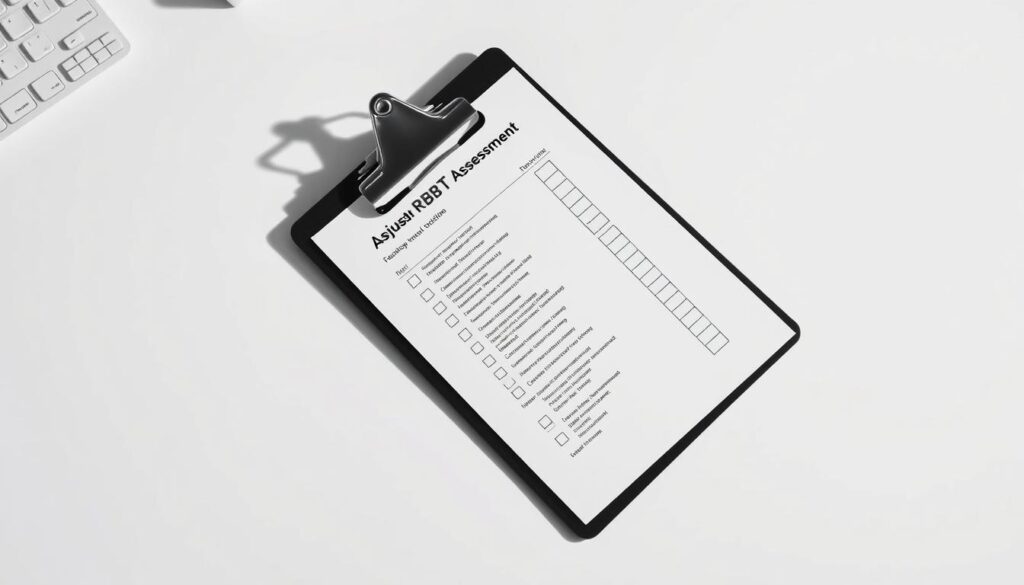
The RBT certification process has a key step: a competency assessment. This test checks if a candidate can apply behavior analysis (ABA) skills. It makes sure they can help people with developmental issues.
Candidates show they can do important ABA tasks with a supervisor watching. The test looks at several key areas:
- Measuring behavior
- Keeping records
- Teaching new skills and reducing bad behaviors
- Being professional and ethical
To get RBT certification, candidates go through a detailed test. A BCBA (Board Certified Behavior Analyst) watches them in real or fake clinical settings.
| Assessment Component | Key Focus Areas | Duration |
|---|---|---|
| Direct Observation | Practical skill demonstration | 60-90 minutes |
| Documentation Review | Accuracy of behavior records | 30-45 minutes |
| Professional Interaction | Communication and ethics | 15-30 minutes |
Candidates need to practice ABA and know the test well. They must show they can help people with behavioral issues.
Preparing for the RBT Certification Exam
To pass the RBT exam, you need a solid plan and lots of study time. You must show you know a lot about applied behavior analysis. This is key for getting certified.
Getting ready for the RBT exam can seem tough. But, with the right tools and methods, you can feel more confident. This will help you do well on the exam.
Essential Study Materials and Resources
Good study materials are vital for RBT exam prep:
- Official BACB Handbook
- Online training modules
- Recommended textbooks on applied behavior analysis
- Digital flashcard sets
- Professional study guides
Practice Tests and Mock Examinations
Practice tests help you get used to the exam style and find areas you need to work on. Here are some top practice resources:
| Resource Type | Benefits | Accessibility |
|---|---|---|
| Online Practice Exams | Simulates actual test environment | Web-based platforms |
| Professional Certification Prep Courses | Comprehensive review and strategy | Online and in-person options |
| BACB Sample Questions | Official practice materials | Direct from certification board |
Test-Taking Strategies for RBT Certification
Being RBT certified is not just about studying. Here are some smart ways to prepare:
- Create a structured study schedule
- Use active recall techniques
- Practice time management
- Review key concepts regularly
- Manage test anxiety through preparation
Remember, consistent preparation and a calm mindset are your greatest assets in achieving RBT certification.
Cost Breakdown of RBT Certification
Getting an RBT certification means you need to know the cost. The price can change based on a few things. You’ll need to pay for training, application, and exam fees.
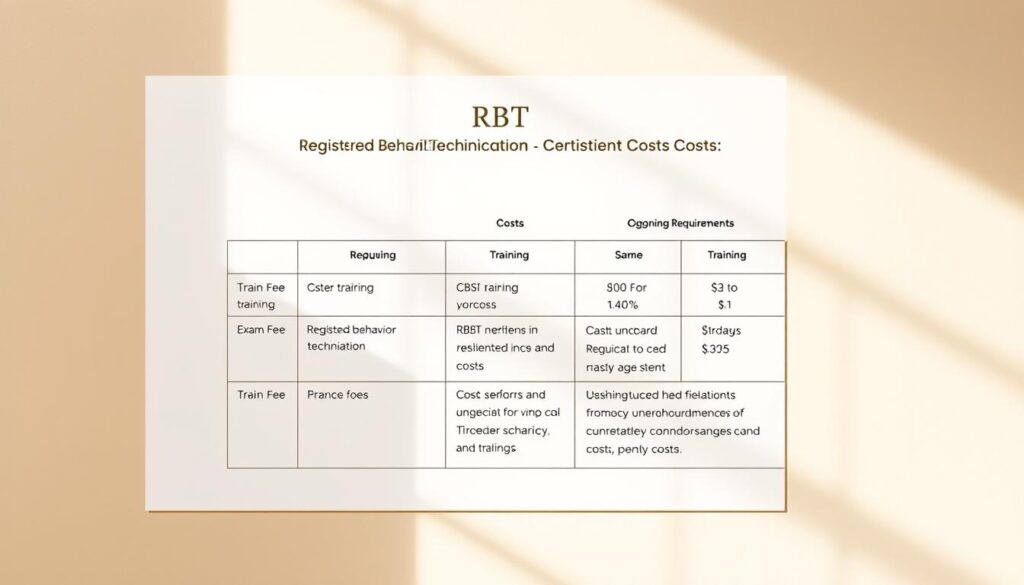
- Training Program Fees: $100 – $500
- Background Check: $30 – $75
- Certification Application: $50 – $100
- Exam Registration: $85 – $150
The total cost for RBT certification is between $265 and $825. Some jobs might help pay for this, which can lower what you have to pay.
| Expense Category | Estimated Cost Range | Potential Savings Options |
|---|---|---|
| Training Program | $100 – $500 | Employer sponsorship |
| Background Check | $30 – $75 | Bulk processing discounts |
| Application Fee | $50 – $100 | Professional association discounts |
| Certification Exam | $85 – $150 | Online study resources |
To save money on RBT certification, you can:
- Look for employer-sponsored training
- Compare different training providers
- Use online study materials
- Check for discounts from professional organizations
Planning ahead can make the RBT certification process more affordable. This way, more people can pursue this rewarding career.
Maintaining Your RBT Certification
Getting your RBT certification online is just the start. Keeping your certification up means you must keep learning and growing. Registered Behavior Technicians need to stay up-to-date to give the best care to their clients.
The RBT certification renewal process is designed to keep your skills sharp. It’s important for professionals to manage their certification well to stay in good standing.
Renewal Requirements
To keep your RBT certification, you need to renew it regularly. The renewal process includes:
- Completing a renewal application
- Passing a background check
- Maintaining supervision requirements
- Documenting ongoing professional performance
Continuing Education Credits
For RBTs, never stop learning. The certification needs ongoing education to keep your skills sharp and up-to-date.
| Education Type | Credit Hours Required | Renewal Frequency |
|---|---|---|
| Professional Training | 4 hours annually | Every 12 months |
| Online Courses | 2 hours minimum | During certification period |
| Supervised Practice | Ongoing documentation | Continuous |
RBT certification online makes it easy to meet education needs. Professionals can find webinars, virtual workshops, and special training modules to keep their credentials.
Being proactive about keeping your certification up ensures RBTs are valuable in healthcare. They are dedicated to giving top-notch behavioral support.
Online vs. In-Person RBT Training Options
Choosing the right RBT training course is key to your career growth. Now, you can pick from online or in-person RBT certification programs.
Online RBT certification is great for those with busy lives. It offers flexible scheduling so you can learn at your own pace. You get to learn ABA principles and practical skills through digital modules.
- Self-paced learning environment
- Accessible from anywhere with internet connection
- Often more cost-effective
- Recorded lecture options
In-person training has its own perks. You get to interact with teachers and classmates, getting feedback right away. It’s a chance to practice skills and have discussions in real time.
- Immediate instructor guidance
- Structured learning environment
- Direct networking opportunities
- Hands-on skill demonstration
Think about your learning style, schedule, and career goals when choosing a course. Some like classroom learning, while others prefer online.
Many organizations now accept online RBT certification. Make sure your program is recognized by the Behavior Analyst Certification Board (BACB) for quality training.
Common Challenges and How to Overcome Them
Getting RBT certified is tough, but knowing the obstacles helps. Many face issues balancing work, life, and getting certified.
Those aiming to be Registered Behavior Technicians meet unique challenges. It’s key to know these to pass the certification process.
Time Management Strategies
Time management is vital for RBT certification. Here are some tips to help:
- Create a structured daily schedule
- Prioritize study time
- Use digital planning tools
- Break large tasks into smaller, manageable segments
Balancing Work and Training
It’s hard to manage work and study at the same time. Here are some tips to keep things balanced:
| Strategy | Implementation |
|---|---|
| Flexible Learning | Online courses with adaptable schedules |
| Evening/Weekend Study | Dedicated time blocks outside work hours |
| Employer Support | Discuss possible training accommodations |
Many RBTs suggest proactive communication with employers. They also advise being realistic about what you can do. With good time management and support, you can make it through the certification process.
Remember, every challenge is temporary. With hard work, you’ll grow professionally. Each hurdle you clear brings you closer to your goal.
State-Specific Requirements and Regulations
Getting certified as a Registered Behavior Technician (RBT) can be tricky. This is because each state has its own rules. The Behavior Analyst Certification Board (BACB) sets a national standard. But, each state might ask for more.
Every state has its own way of handling RBT certification. Some important things to think about are:
- Specific licensing requirements
- Background check protocols
- Additional training mandates
- Supervision guidelines
The steps to get certified as an RBT differ from state to state. Knowing the local rules is key to finding a job and being respected in your field.
To get a handle on state rules, you should:
- Contact your state’s behavioral health board
- Review local licensing requirements
- Check for any supplemental training needed
- Verify supervision standards
It’s also important to keep up with changes in state rules. Some states might ask for:
- Additional background screenings
- Continuing education credits
- Periodic license renewals
- Specific documentation
Knowing the state rules for RBT certification helps you move forward in your career. By doing your homework and talking to local officials, you can meet these requirements easily.
Finding Employment After Certification
After getting your RBT certification, you start looking for jobs. The job market for behavior technicians is full of opportunities. You can find work in many different places.
Good job search strategies are key to finding the right job. Here are some tips:
- Use job boards that focus on ABA therapy
- Join professional behavior analysis groups
- Go to job fairs in healthcare and special education
- Reach out to people you met during your training
When making your resume, show off your new RBT certification. Talk about your training and any special skills you have. Highlight your dedication to helping people with behavioral challenges.
There are many places where you can work as an RBT:
- Autism treatment centers
- Schools with special education programs
- Private therapy clinics
- Home-based services
- Organizations that support developmental disabilities
Getting ready for RBT jobs is important. Work on your interview skills. Put together a portfolio of your training. Show your passion for helping people learn important life skills.
Use online sites like LinkedIn, indeed.com, and ABA job websites. Many employers look for RBTs who are eager and professional.
Conclusion
Getting RBT certified takes hard work, smart planning, and a real love for helping people with autism. It means getting the right training, meeting certain education needs, and passing a tough test. Every step you take gets you closer to a rewarding job in applied behavior analysis.
Your effort to get RBT certified shows you’re serious about growing in your career and helping others. By following the steps from training to passing the test, you’re becoming a skilled helper. You’ll be ready to support people and families with proven methods.
The world of behavior analysis is full of chances for those who want to make a difference. Becoming an RBT can lead to a fulfilling career and personal growth. Keep learning, stay on track with your goals, and know each step brings you closer to your dream.
We urge you to move forward in your career. Look for ABA therapy centers near you, join professional groups, and find more resources for RBT certification. Your journey in behavioral healthcare begins today.
